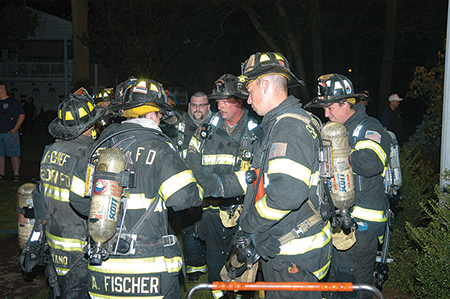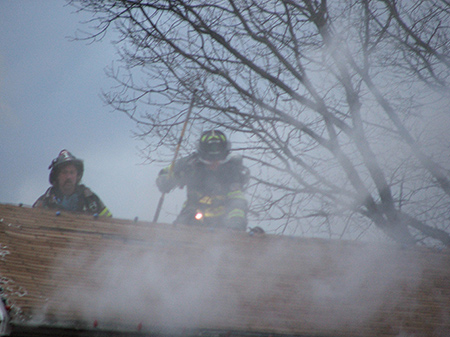
By DENNIS CARMAN
When you consider rapid intervention training, most of your time and energy is spent on teaching a new technique (a drag, 2-1 advantage, and so on) or working on your proficiency with a particular maneuver. Have you and your training staff ever discussed or actually spent time training on how your members would locate a down firefighter whose personal alert safety system (PASS) device is on full alert? Your firefighters can have the best training in the world on techniques or maneuvers, but this will mean little if you cannot locate the down firefighter.
Our members should have the ability to locate a down firefighter’s activated PASS device not only by sight (which, in most cases, will be very limited because of conditions) but also by their sense of hearing so they can narrow down the possible directions. This is the conditioning we look to instill in each member. The rescuers will need to focus on the sound and then pick in which direction to move. This is no easy task depending on the environment, fire conditions, building occupants, and building size. This article presents a simple drill that requires little to no advanced planning or setup.
 |
| (1) You must train your firefighters to restore self-contained breathing apparatus to a full and deactivated state to avoid false alarms. (Photo by Dennis Whittam.) |
The False PASS Activation
The PASS device is part of our equipment to help make us safe and help our fellow firefighters locate us if we get lost or injured during the firefight. As a fireground instructor and an active firefighter, I have seen firsthand how we as a group have become complacent with our PASS devices. As more members arrive on scene, these members may be standing fast and awaiting orders, only to get caught up in other fireground events when-now-someone in the group has a fully activated PASS device.
Another form of complacency witnessed on the fireground is when members exit the immediately dangerous to life or health environment and place their self-contained breathing apparatus (SCBA) or a piece of the SCBA down on the ground only to cause a false activation. Every false activation that we hear goes into our memory bank and, after some time, we just say, “Oh, just another false alarm.” We need to overcome this mindset and reprogram our firefighters before tragedy strikes. The PASS device is a tool to save us.
 |
| (2) This training isn’t about a victim. It is about pinpointing the activated PASS device. (Photo by author.) |
How many times have you responded to an automatic alarm in a commercial occupancy with nothing showing? As the group is waiting for direction, someone’s PASS device activates while everyone continues to discuss the topic of the night such as the latest sports game or dinner; they do not give a second thought to the fact that the sound is coming from one of them. Now, all of a sudden, someone’s PASS alarm is on full alert!
What do you hear other than the PASS alarm sound? Is the sound clear or muffled? Is it echoing all over the place? Can you easily find it, or could you find it in a smoky environment? This is where this drill comes into play.
The Drill and Its Variations
This drill is limited only by your imagination. You can use any space you may have available, such as the apparatus floor. The ONLY objective of this drill is to pinpoint the location of the PASS device.
To begin, remove all of the apparatus from the building you plan to use. Then, hide a PASS device somewhere in this space and use a stopwatch to time how long it takes your members to find the alarm. This will give you an idea of how long it takes each search team to meet your objective. The drill ends when the search team locates the PASS device. After the drill’s completion, take a few minutes to discuss with the team the next course of action based on air management. Do members all have enough air to perform a rescue? Can they begin moving the down firefighter closer to the exit, or will they need a second team to relieve them? Timing the team with a stopwatch will motivate firefighters, who are competitive by nature, to practice this drill.
 |
| (3) A search team formulates a plan to locate the PASS device. (Photo by Dennis Whittam.) |
Also, watch and listen not only to the officer but also to the firefighters to see the different plans that each team comes up with. Did they follow the plan? Was there a long time frame between hearing and then responding to the alarm? If you placed the PASS device in the middle of the apparatus floor, are the members deploying a search rope or are they performing your normal search with a right-hand or left-hand lead, which will cause a long delay in finding a down member?
As part of the search team’s plan, someone must decide which way to go. This will not be an easy decision because, in part, of the echoing coming from the alarm. This is where the learning starts; going forward, you will have the ability to make the drill more complex.
At the completion of the drill, discuss the different plans each team came up with and discuss their pros and cons based on your observations. No one is “wrong” during this training, but there may be a plan that worked better than another. Remember, every situation will be different on the fireground.
For the next training session, leave a few pieces of apparatus in the building. But this time, place the PASS device in a compartment of one of the vehicles. Doing this will muffle the sound of the alarm. Again, listen to the search team as members formulate a plan based on what they are hearing and from where the noise is coming. Does the team split into two teams that come from different directions? As in the first evolution, someone should time how long it takes to get to the PASS device.
 |
| (4) What happens when the firefighter doesn’t fall all the way through the roof and attic? (Photo by author.) |
As you think or plan for this drill, consider how many firefighters lose consciousness in an upright or standing position. The answer is very few, if any. The firefighter who is having issues will end up on the floor in some kind of prone position. No one can predict the position in which a member may end up during an emergency. Firefighters in real-world events have passed out only to land in a position that covers their PASS device. What if water builds up on the floor of the fire building? What do you think that PASS alarm will sound like?
Adding a “Twist”
I like to add a “twist” to this drill after a few sessions by placing the PASS device on top of one of the engine’s hosebeds or in the ceiling above the apparatus floor. Here, you can leave all the apparatus in place or move some of it out of the way. You may ask, “Why would I put the PASS alarm in the ceiling?” We always assume that our down firefighter will be found lying on the floor, either from disorientation, a medical emergency, or a partial collapse where the member fell through the floor. What happens when the firefighter doesn’t fall all the way through the floor to the floor below? If you are operating at a two-story house and you are on the first floor, where will the PASS device sound be coming from? What if your firefighter operating on the roof falls through the roof in a collapse only to land in the attic? You now have a member trapped above rescuers searching for him. If the roof firefighter is conscious, perhaps he can radio in his location. If he cannot use the radio, then he can use the tools he brought to the roof (if they haven’t been lost in the collapse). Either way, the member or his PASS device will sound from above.
The possibilities for this type of training are endless; all of your members should participate because you never know when things are going to go bad. When they do go bad, it will happen quickly. Just because you have a firefighter assist and search or a rapid intervention team is assigned to the alarm doesn’t guarantee they will be on scene when something goes wrong. Every single one of your members should learn how to locate a PASS device in a hostile environment because “you just never know!”
DENNIS CARMAN is a New York State and nationally certified fire instructor. He is also a deputy chief instructor for the Suffolk County (NY) Fire Academy. Carman is a 29-year member of the Selden (NY) Fire Department’s Truck Co. 1. He has served as an advisor to the Brookhaven (NY) Town Chief’s Council for Rapid Intervention.
Drill of the Week: Rapid Intervention Size-up
More Rapid Intervention : “Grab-and-Go” Turnout Handles
Training Days: Rapid Intervention

